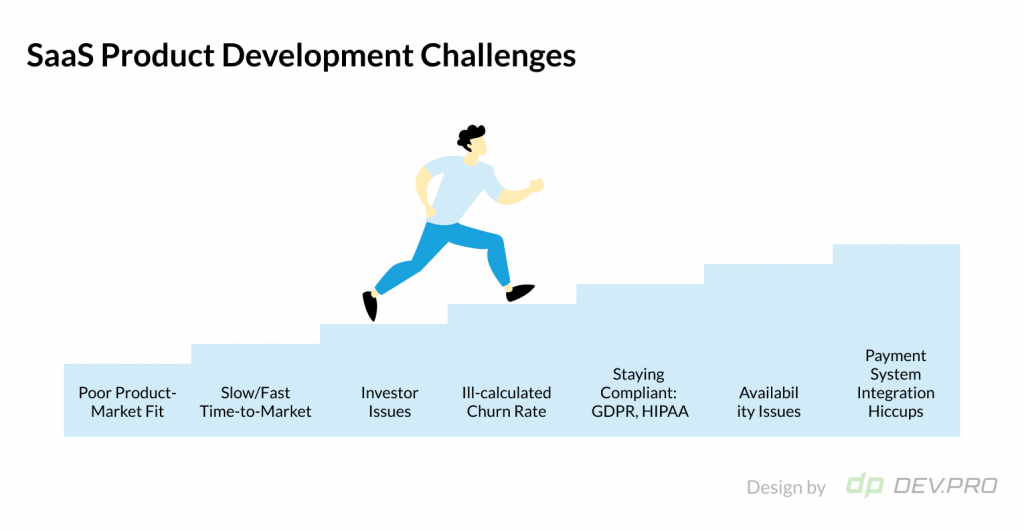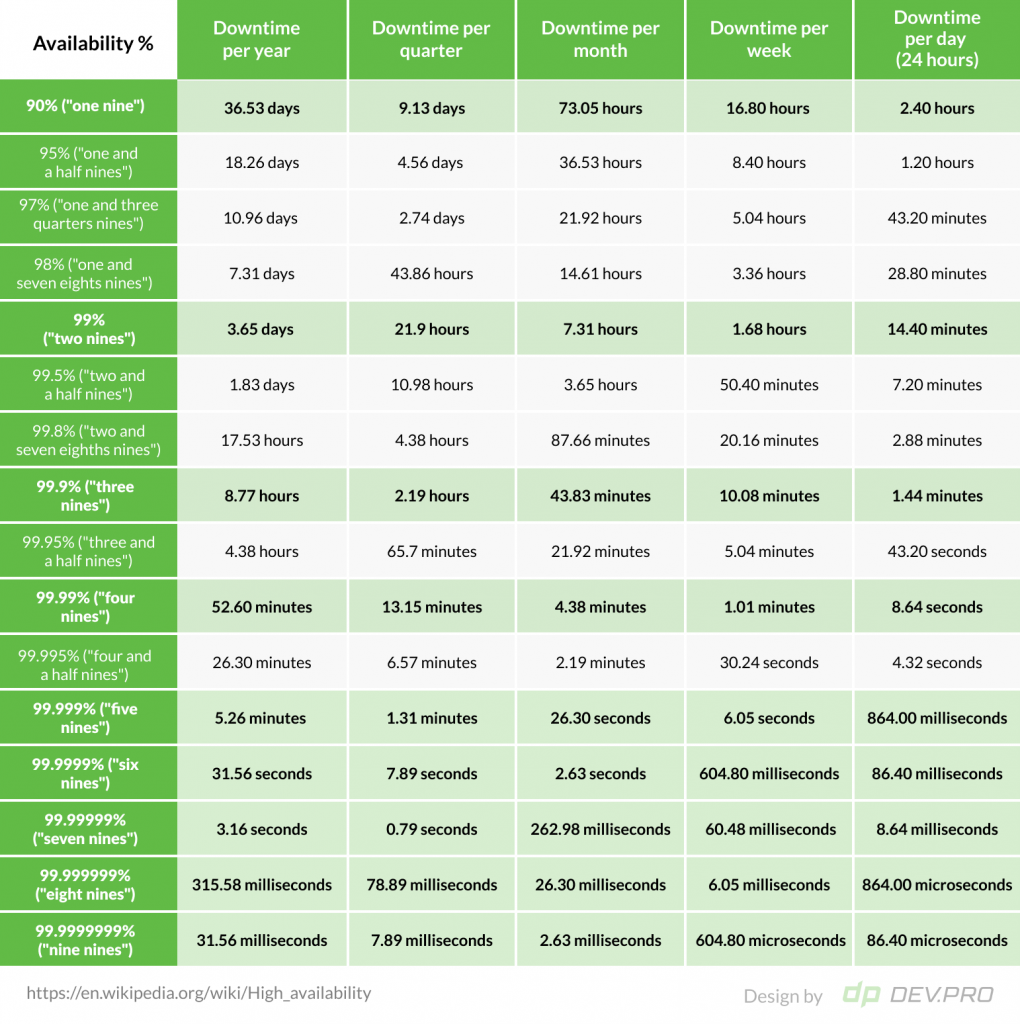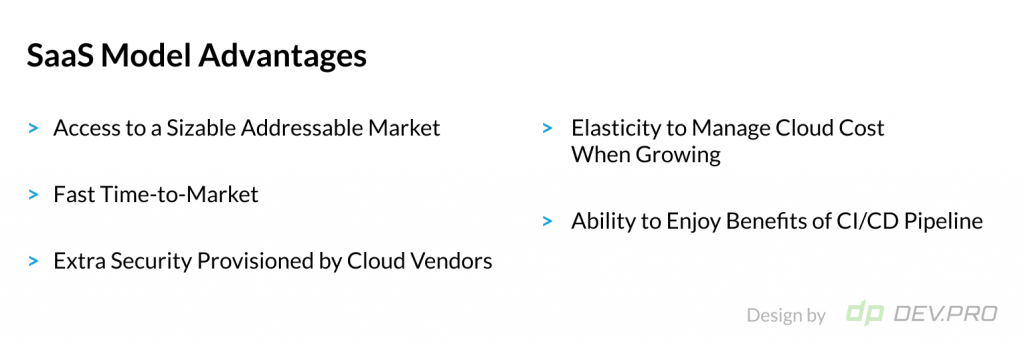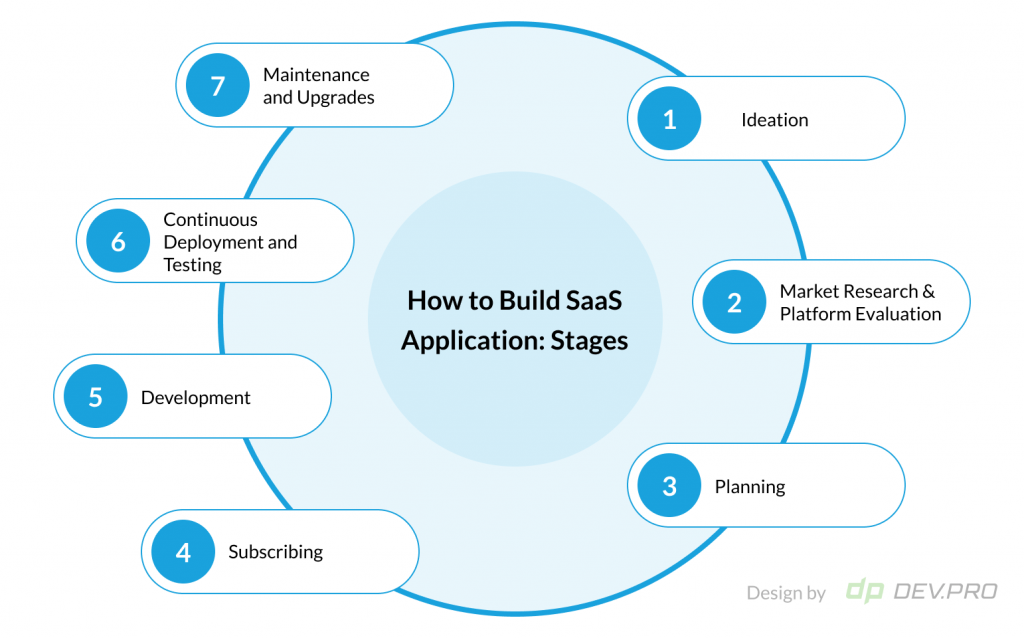Shopify, Adobe, Zoom, Atlassian, Salesforce — do these names ring a bell? They are some of the biggest SaaS companies and are worth tens and even hundreds of billions dollars. With the proliferation of cloud computing, 5G, and work from home culture, SaaS product development is growing exponentially.
Gartner forecasts that the worldwide public cloud application service market will grow from $120 billion in 2020 to $145 billion in 2021 and add another $26 billion in 2022.
DevPro’s dedicated development teams help create numerous SaaS applications for US-based clients and our software engineers love the scalability, security, resilience, and high availability that come with the technology.
Let’s learn how to build a SaaS application in 2022, the main challenges and benefits of this technology, as well as a blueprint for hiring a tech partner.
What is a SaaS Application?
SaaS stands for Software as a Service and it means that a business using the product has no responsibility for the underlying technologies, like networking, storage, servers, O/S, Runtime, DB, or even applications. A client gets access to the software at a monthly or yearly subscription fee, while the provider takes care of all of the hardware, software and everything in between [middleware].
Let’s take making pancakes as an example. If you want to eat pancakes, you can:
- order pancakes at a diner,
- fry and garnish some frozen pancakes,
- make pancakes at home from just-add-water pancake mix, or
- make them from scratch, eggs and all.
Similarly, different forms of X-as-a-Service [IaaS, PaaS, SaaS] extend different levels of responsibility a client undertakes before using the product. A SaaS model offers the least involvement from the client’s side.
For example, you can pay $29 and use all of Shopify’s sophisticated features, like payment processing, dropshipping integration, analytics, and store management. You don’t need to know how to hire a software developer, how much cloud storage costs, or how to integrate a payment gateway into your ecommerce website. They’ve done it all for you. Just pay $29 a month.
Hence the definition of the SaaS application:
A SaaS application is one of the 3 major software delivery and licensing formats. [The other two models are IaaS and PaaS.] A provider develops a centrally-hosted application and distributes it to the final user on a subscription basis.
While the technology has multiple advantages for both vendors and clients, every silver lining comes with a cloud. These are the key obstacles SaaS developers face.
Common Challenges in SaaS Product Development
Teams with expertise in how to build a SaaS know that technical, organizational, financial, conceptual, and market-driven obstacles often fall in the path of a SaaS product manager.
The issues below are both common and critical.

Product-Market Fit
Ensuring a feasible product-market fit at the ideation phase is fundamental. The ideal combo is a solid addressable market AND a solution to a topical problem that you address with your application. The 40% rule says that at least 40% of the surveyed will need to either be “very disappointed” if a product ceased to exist, or consider it a “must-have” for an application to be considered a good market fit.
Slow/Fast Time-to-Market
Some ideas are ahead of their time, which means that the target audience is too limited, however advanced the solution is. Some ideas sit on the shelf too long or take too much time to implement, allowing other teams to outpace them. Successful SaaS development teams will be able to have a grasp on the market readiness of your idea and the resources they’ll need for prompt product development.
Investor Issues
Whether it’s a big venture fund or an angel from your friends and family circle, investors risk their money on your idea. If you are in it for the long game and your product is lucrative enough to attract a few investors, it’s often a good move to choose more experienced investors who keep close rapport with their teams. You get the mentor and the advisor value out of this relationship, which is possibly more valuable than funds.
Disclosure: there is no best practice for how to avoid investor issues – everyone has them, but doing your due diligence helps ease the process.
Churn Rate
Customer acquisition is a critical KPI at the beginning, so getting a strong marketing mind onboard is as vital as hiring an experienced software development team. Keep your churn rate lower than your acquisition rate and your chances of survival or making it to the next round of funding increase exponentially.
Staying Compliant: GDPR, HIPAA
WhatsApp paid a quarter of a billion in GDPR fines in the first three years of the law’s existence, while Amazon paid over three times as much: $877 million. Data security features should be embedded into your entire SDLC, starting from the choice of cloud service vendors, third party tools, database, and data storage management practices.
High Availability
SaaS products cater to thousands of businesses, so any downtime may cost millions of dollars TIMES thousands of companies they serve. High availability is what needs to be guaranteed as the first clause in all of your suppliers’ SLA contracts, with at least five nines as standard.

Payment System Integration
All SaaS products need payment system integrations. There are lots of questions to answer here, like hierarchy of transaction commissions, PCI compliance, and choice of payment method portfolios. A good start is to ensure that your system integration software engineers are PCI certified.
The Sunny Side of SaaS Model
Now that we have an understanding of the potential stumbling blocks to building a SaaS product, let’s see why so many businesses choose this model.

Access to a Sizable Addressable Market
A subscription model allows SaaS companies to split the cost of developing and maintaining a software system between thousands and millions of users in manageable monthly payments. This provides an opportunity for a much bigger potential pool of clients, than needing a huge one-time upfront investment.
Fast Time-to-Market
Cloud technology goes hand-in-hand with SaaS development processes and creates a secure deployment environment that is also scalability-friendly. Moreover, SaaS application development companies can also use a PaaS or IaaS as their basis, transferring the financial and talent resource management burden onto the provider for a fee.
Extra Security Provisioned by Cloud Vendors
If you choose to host your SaaS application on AWS, GCP, or Azure, the security assurance provided by all major cloud providers is unparalleled. These companies hire the best cybersecurity professionals to offer the most guarded parameters for their clients.
Elasticity to Manage Cloud Cost When Growing
Cloud cost optimization is a complex topic, yet it’s an industry-wide consensus that cloud vendors provide multiple tools to reduce your costs through right-sizing and right-costing. Multiple FinOps techniques exist to ensure you can measure your consumption and match it to the best available cloud offers, so that you only pay for what you consume.
Ability to Enjoy Benefits of CI/CD Pipeline
Automation and the ability to integrate testing from the earliest phases of the SDLC are just a few of the non-negotiable SaaS development principles our DevOps engineers swear by. The benefits of Continuous Integration and Continuous Development are overwhelming, making this practice a default option for many SaaS Development companies.
With hurdles and rewards out of the way, let’s review the milestones of the SaaS development process.
How to Build SaaS Application: From Ideation to Maintenance
The SaaS Development Lifecycle echoes the regular SDLC quite closely. Let’s dive into the process:

1. Ideation
The ideation stage may seem like a marketing and product taxonomy, but it gets highly technical on the way too. This is why the group of talent contributing to this phase should include the CTO, Chief Engineer, an Enterprise and a Cloud Architect, as well as the CMO, Head of Sales, and Product Owner.
Armed with the market, vertical, and opportunity research from industry experts of the Gartner caliber, the ideation team needs to make a number of mission-critical decisions that will define the success of the project:
- Provide financial rationale, wherein the cost of software development is justified against the investment with understanding of where the death valley ends and revenues start coming in, contingency plan, etc.
- Determine how much of the product will be developed in-house, how much will be outsourced to third-party software development companies or purchased from Independent Software Vendors [ISVs]. The decision of whether to buy or build will have a significant impact on the outcome of the venture.
- Conduct evaluation and final selection of the cloud service vendors to host, develop, and deploy the application on.
- Produce a number of deliverables, like Proof of Concept, daft of the scope of service for the short and long term.
With strategic decisions and feasibility study done, it’s time to arrive at a major technical verdict and select a cloud platform provider.
2. Market Research & Platform Evaluation
This decision has many technicalities to account for and will involve all major tech talent, including cloud engineers, DevOps experts, and a solution architect. Based on the industry best practices, failure and success stories in the vertical, thorough audit of the SLA agreements and multiple technical side-by-side analysis of the major cloud platforms, the team needs to decide on the best fit.
The shortlisted candidates will undergo the trial process for the final selection stage. At the same time, the team will also deliver a finer POC [Proof of Concept], the roadmap for the following step, and a service architecture through the lens of the selected cloud provider.
3. Planning
The deliverable documents at this stage include: Project, Resource and Communication Plans, a Risk Mitigation Strategy, a Design Blueprint, and SaaS Architecture.
A team needs to go through all the resources needed and available for the project’s implementation, weighing them against investment and timelines to chart a plan for all departments involved, from development to marketing.
4. Subscribing
The subscribing stage is mostly technical, so all of the project’s architects and IT minds will join their efforts with legal and procurement department reps to finalize the deal with the shortlisted cloud service provider. A sales manager and respective technical specialists on the side of the vendor join the process to offer the best fitting set of cloud services in accordance with your tech requirements.
This is the time to go through all technicalities in your Service Level Agreement, decide if you are going after PaaS or IaaS, review a disaster recovery plan and security certifications, elaborate cloud design patterns, and negotiate and purchase the production subscription.
5. Development
Solutions architects, Software developers, and DevOps specialists and testers are the main agents of this stage. They turn the planned product architecture into code artifacts.
The team starts with setting up the development environment, initiating the coding process. All of the existing infrastructure as well as all of the cloud toolchain will be integrated together according to the predefined architecture and roadmap.
6. Continuous Deployment and Testing
CI/CD practices are critical for the process of sustainable SaaS product development. At this stage the DevOps team works in close cooperation with testers and security engineers to establish continuous integration, deployment, and testing practices.
Load testing and other forms of performance testing are critical to ensure high resilience of the application under conditions of fluctuating workloads. Scalability should be embedded in every application according to the addressable market, marketing efforts, and other pertinent factors.
Disaster recovery plans and business contingency plans will be elaborated at this stage for all processes and tools.
7. Maintenance and Upgrades
As the SaaS project goes live, it will both:
- Need to be maintained as is with workloads applied to systems and revealing new bottlenecks
- Require new upgrades as business requirements change and new services are added to the architecture.
Depending on how disruptive and tightly coupled the new feature may be, teams may have to repeat the process from stages one through to seven to integrate it seamlessly without loss of availability.
Build SaaS Application: Tech Stack And Architecture
There are many technical decisions to account for, so we thought to answer some major ones here:
What Programming Language Should I Use for SaaS Development?
Anything that your team knows, that’s easy to hire developers for, and that’s not on its downward curve in terms of demand.
Python, JavaScript, PHP, C#, Java, Ruby on Rails, Scala, Elixir, Golang can all be used for this purpose.
Which Cloud Service Provider to Choose
There’s no right or wrong answer here.
AWS is number one in the world and has plenty of cloud services to offer as well as a number of tools to monitor and control your cloud costs.
GCP is a solid cloud product with a suite of comparable products when it comes to key functionalities.
Azure, Alibaba, and a number of other third-party cloud providers create an ample offering on the market.
Your SaaS product design team will have a big decision to make. A number of parameters go into the verdict, including your current vendors across the company, your architecture, compute and storage capacities, IaaS vs PaaS, and security and compliance factors .
SaaS Architecture: Key Decisions
Monolith is still an option, especially if you have limited time and talent. If you create a B2C application, that does not suggest fast exponential user growth, it can be another point in the monolith basket.
Microservices may require more resources to set up but are easier to scale. If you have your investments in, this might be the way to go.
Developing multi-tenant multi-cloud SaaS systems may also prove more viable in the long term, as they allow for minimal downtime and high availability among other benefits.
How to Build a SaaS Application With a Tech Vendor
You may consider hiring a tech partner to develop a SaaS product. Vendors can increase time-to-market, offer proven shift & lift expertise, and can give you immediate access to talent.
While some inherent risks are present in outsourcing SaaS development, a proper vendor selection process can prevent these risks and a well-compiled SLA will provide a legal framework.
The blueprints of the process are described in detail in this article. These are your major steps:
- Select 5-10 software development vendors specializing on SaaS application development from different destinations, like the US, LatAm countries, Eastern European countries, and EMEA.
- Send your request for proposal with detailed project requirements.
- Gather all responses and shortlist 2-3 candidates
- Conduct final round of interviews via video conferencing.
- Request legal papers [SLA, NDA, etc] from the finalists and choose your vendors based on extensive team discussions.
Not only is it often cheaper to get an extension team onboard, but it also means you always have a second opinion to rely on in terms of architectural strategic decisions.
Looking for a SaaS development company to help you drive the process quicker? Speak to our sales team to discuss the details. Are you into the small steps mentality? Let’s give it a try and start with SaaS development consulting services.


